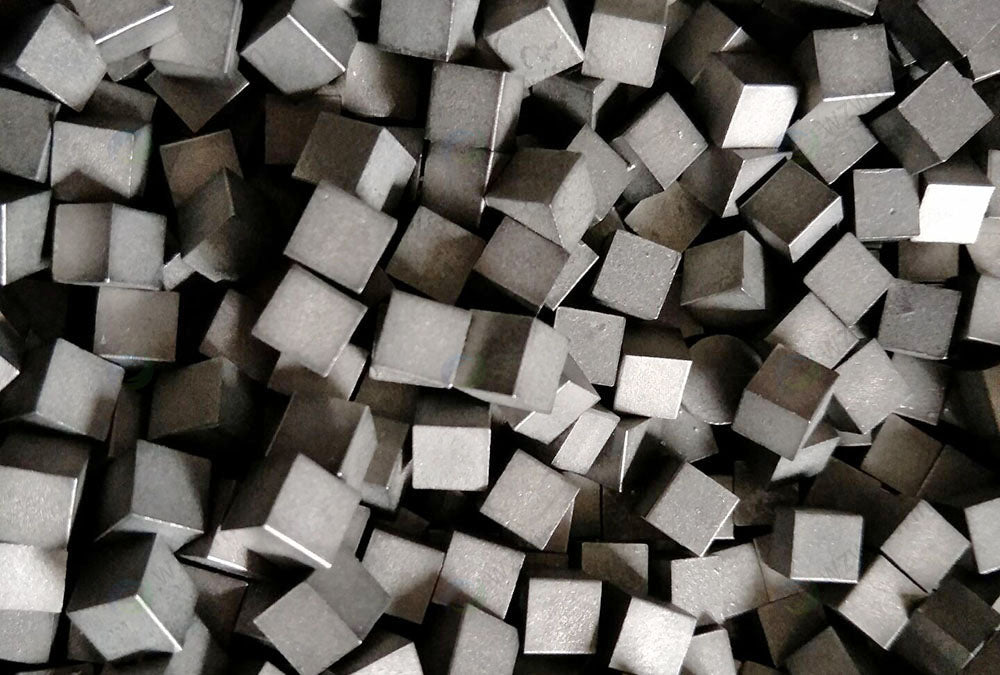
Does Tungsten-Nickel-Iron Alloy Exhibit Magnetism?
Tungsten-nickel-iron alloy (W-Ni-Fe alloy) is a composite material primarily composed of tungsten, with nickel and iron serving as the binding phase. Typically containing over 90% tungsten, the remainder consists of a Ni-Fe mixture in ratios such as 95W-3Ni-2Fe or 93W-5Ni-2Fe. Due to its high density (≈16.5–18.5 g/cm³), strength, corrosion resistance, and machinability, this alloy is widely used in defense, aerospace, medical, and industrial applications. A common inquiry is whether this alloy possesses magnetic properties.
Magnetic Nature Overview
Magnetism describes a material’s response to a magnetic field and is generally classified as ferromagnetism, paramagnetism, diamagnetism, or ferrimagnetism.
-
Ferromagnetic materials (e.g., Fe, Ni, Co) exhibit strong magnetization and retain residual magnetism.
-
Paramagnetic materials (e.g., Al) show weak attraction to magnetic fields.
-
Diamagnetic materials (e.g., Cu) repel magnetic fields.
The magnetism of an alloy depends on both the magnetic properties of its constituent elements and its microstructure.
Magnetic Behavior of W-Ni-Fe Alloys
Tungsten (W) itself is non-magnetic, even slightly diamagnetic, due to the absence of unpaired electron spin moments. In contrast, iron (Fe) and nickel (Ni) are ferromagnetic, with iron exhibiting high saturation magnetization and nickel having good magnetic permeability. Therefore, the magnetism of W-Ni-Fe alloys originates mainly from Fe and Ni, while tungsten acts as a structural and diluting phase.
These alloys are generally classified as soft magnetic materials—characterized by narrow hysteresis loops, low coercivity, and high permeability—suitable for applications requiring frequent magnetization and demagnetization. When the total Ni and Fe content ranges from 3% to 20%, the alloy exhibits typical soft magnetic behavior. In this range, the Fe-Ni network forms a continuous magnetic phase, while dispersed tungsten particles interrupt domain coupling, reducing overall magnetization. Increasing Fe enhances saturation magnetization but also raises hysteresis loss.

Influencing Factors
1. Composition Ratio
The Ni:Fe ratio critically affects magnetic performance. When Ni:Fe ≈ 3:1, permeability reaches its peak—similar to optimized high-permeability Ni-Fe alloys—due to an ordered crystal structure that facilitates domain wall movement.
-
Higher Fe increases saturation magnetization but lowers permeability and raises coercivity, shifting behavior toward hard magnetism.
-
Higher Ni improves toughness and corrosion resistance but weakens magnetism due to Ni’s lower magnetic moment.
-
Higher W content dilutes the magnetic phase, weakening magnetism overall.
2. Microstructure and Processing
W-Ni-Fe alloys are typically produced by powder metallurgy, involving powder mixing, compaction, sintering, and heat treatment. During sintering, Fe and Ni form a liquid phase that wets the tungsten particles, producing a dual-phase structure:
-
W-rich phase: body-centered cubic (bcc)
-
Ni-Fe solid solution phase: face-centered cubic (fcc)
Uniform tungsten distribution and continuous Ni-Fe networks enhance magnetic pathways and permeability. Defects such as pores, impurities, or phase separation reduce magnetic performance. Annealing relieves internal stresses, aligns grains, and lowers hysteresis loss. Finer grains improve magnetization by reducing domain wall pinning and enhancing magnetic coupling. Structural phase transitions under strong fields may affect magnetism but are uncommon at room temperature.
3. Temperature
Magnetic properties vary with temperature. The Curie temperature (Tc), above which magnetism vanishes, depends on the Ni-Fe phase—typically 400–600 °C, lower than pure iron (770 °C)—due to tungsten’s weakening of exchange interactions.
At low temperatures, permeability increases as thermal agitation decreases; at higher temperatures, magnetism diminishes.

Comparison with Other Alloys
-
Pure Tungsten (W): Completely non-magnetic; used where magnetic interference must be avoided.
-
Tungsten-Nickel-Copper (W-Ni-Cu): Non-magnetic because Cu is diamagnetic; preferred in magnetic-sensitive devices (e.g., MRI).
-
Tungsten-Nickel-Iron (W-Ni-Fe): Magnetic, stronger, and denser than W-Ni-Cu; unsuitable for magnetic-free environments but ideal for electromagnetic shielding or weighted magnetic components.
-
Ni-Fe Binary Alloys: Exhibit higher permeability but much lower density than W-Ni-Fe, making W-Ni-Fe advantageous where high mass and moderate magnetism are required.
Summary:
W-Ni-Fe alloy exhibits soft magnetic behavior derived from its Fe-Ni phase. Its magnetism can be tuned through compositional adjustment, microstructural control, and heat treatment. While weaker than conventional soft magnetic steels, it offers superior density and mechanical robustness, balancing magnetic performance with structural integrity.
